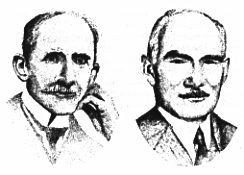 Fleming and DeForest
Fleming and DeForest1904: thermionic value--electrons in vacuum tube, with heated cathode wire (source of electrons), flow in the singely in the direction of the anode (positively changed to attract the electrons). Electrons flow in only one direction, from cathode to anode. This makes it possible to generate a direct current from an alternating current (aka "rectifier"). Device is called a "diode" for its two inputs. Works for high frequency waves as in radio -- could be used as a radio detector.
Professor at University College, London, and was an advisor to the Marconi Company.
1906: Adds third electrode to Fleming value--wire mesh grid placed between electron-emitting cathode and positive potential anode. Device is called a "triode." Changing the voltage on the grid modifies the current on the anode (changes the number of electrons flowing to the anode). Acts just like a water or gas valve, except for electron flow. Amplified signal emerges at the anode.
"A wonderful character, a churl, a rogue, a cad, a thief, a romantic, and yet probably the man most responsible for bringing radio broadcasting to the American public." Susan Douglas, Radio Historian
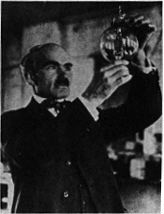 1899:
PhD, Yale University. Series of jobs at Western Electric and American Wireless
Telegraph Company. Starts several companies that rise and fall in stock
speculation schemes.
1899:
PhD, Yale University. Series of jobs at Western Electric and American Wireless
Telegraph Company. Starts several companies that rise and fall in stock
speculation schemes.
1900: Invents the responder, a acoustic device that does away with Marconi's coherer and allows key operator to work with headphones rather than telegraph inker.
1906: Similar to Fleming and von Lieben. Thin-wire "grid" between cathode and anode. Bent and zig-zigged to increase the surface area of the grid. Device, called "audion" used for detection and amplification. Real contribution was to combine triode with a resonant circuit to yield an efficient way to generate a continuous high frequency signals. Leads to the replacement of spark gap transmitters.

1907: Early experiments in transmitting voice and music.
1910: Radio Telephone--take sound waves impinging on a microphone, modulate and amplify these onto a continuous high-frequency oscillating signal (a "carrier" signal). Transmit these as a Hertzian wave. Receive, amplify, rectify and transform back into sound via a loud speaker.
1910: First musical broadcast from the stage of the Metropolitan Opera (Enrico Caruso in I Pagliacci).
1916: Sets up own radio station.
1904: Ernst Alexanderson, at GE, develops an ingenious alternating current generator able to generate signals at 100,000 cycles per second. High enough to use modulation to carry human voice. But device is huge: large rotating disk spinning in a magnetic field at 20,000 revolutions per minute.
1906: Christmas Eve, Fessenden transmits voice, poetry, music to ships in the Atlantic. Wireless becomes radio, telegraphy becomes broadcasting.
"That night, ship operators and amateurs heard the results: `someone speaking! . . . a woman's voice rose in song. . . . Next someone was heard reading a poem.' "
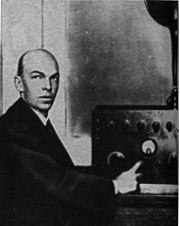 1912:
Invents regeneration. Exploits feedback in the audion circuit to
dramatically improve reception sensitivity: feed oscillating current from
plate back to the grid. Much more sensitive reception becomes possible:
able to pick up dots and dashes from England or Hawaii on US east coast.
Leads to long legal squabble between Armstrong and De Forest over who invented
amplification. Finally resolved by the Supreme Court in 1928, in De Forest's
favor (despite the fact that De Forest could not explain why his device
provided amplification).
1912:
Invents regeneration. Exploits feedback in the audion circuit to
dramatically improve reception sensitivity: feed oscillating current from
plate back to the grid. Much more sensitive reception becomes possible:
able to pick up dots and dashes from England or Hawaii on US east coast.
Leads to long legal squabble between Armstrong and De Forest over who invented
amplification. Finally resolved by the Supreme Court in 1928, in De Forest's
favor (despite the fact that De Forest could not explain why his device
provided amplification).
1918: Armstrong a Captain in US Army Signal Corp. Invents superheterodyne detection, opens up access to higher frequency transmission and reception. Based on work of Fessenden: he had discovered that two incoming radio signals of different frequencies could be mixed to yield a thrid signal with frequency that is the difference of the other two. He called this hetero - "other" - dyne - "force."
Superheterodyne (SH): Principle is to mix a carrier frequency with a local oscillation frequency to generate an lower frequency intermediate waveform that is easier to process. Regeneration circuit used both as a receiver and oscillator of radio waves.
1. SH receiver picks up high frequency, heterodynes it with another reference wave to obtain a wave of intermediate frequency (IF).
2. IF travels thru amplifier to increase its power several thousand times.
3. Regeneration circuit detects the wave and converts it to direct current.
4. Current passes through audio amplifier to earphones or a speaker.
1921: Superregeneration. Howling sound when regenerated signal is passed through amplifier more than 20,000 times in one second. Suppresses the noise by developing a new quenching circuit to limit the number of feedback cycles to less than 20,000. Yields very high levels of amplification. But oscillator also acts like a transmitter, and so interfers with near-by receivers. Never as commercially successful as his other inventions.
1933: frequency modulation (FM). Encode sounds not by modulating the amplitude of a carrier waveform, but its frequency. Goal was to eliminate static. Noise tends to distort signal amplitudes, has much less effect on frequency distortions.
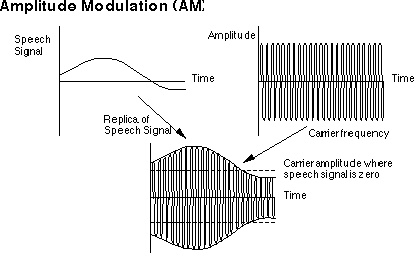
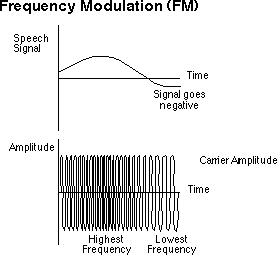
Theoretical analysis by AT&T scientists indicated that FM would not work. Turns out that the analysis, limited to narrow frequency band, was not valid for wide-band transmission. When Armstrong developed his wide-band FM system, it yielded much better fidelity in the received sound.
Required new receiver designs: (1) limiter circuit removes amplitude changes in the received signal, (2) descriminator circuit translates frequency changes back into amplitude changes.
Second advantage: circumvents the capture effect that affected AM transmissions.
1935: 5 November--First public demonstration of FM broadcasting, from experimental transmitter at the Empire State Building. Crumpling paper, tearing paper, reverberations of a small Oriental gong being tapped lightly, record of a Sousa march, etc. Audio fidelity of a level never heard before. Testing stopped when RCA wanted access to the transmitter for experimental television broadcasts.
World War II and machinations by RCA halt development of FM. FM widely used in American communications systems developed during the war. Armstrong gave up his patent rights for the war effort.
1945: FM stations go into operation.
Early 1950s: RCA develops an alternative form of FM system that it claims circumvents Armstrong's patents. System actually did not work very well. RCA ties up Armstrong in the courts. Armstrong sues RCA, claiming that the company had conspired to discourage FM, had persuaded the FCC to allocate it an inadequate number of suitable frequencies, and had illegally obstructed Armstrong's patent applications.
1953: Armstrong demonstrates radio multiplexing--the ability to transmit multiple signals on the same FM waveform. This eventually led to FM's ability to transmit stereo audio signals.
1954: 2 February. Armstrong, his fortune lost on pursuing his patent claims against RCA, jumps out of a window and kills himself. Eventually his wife succeeds in winning the legal battles.
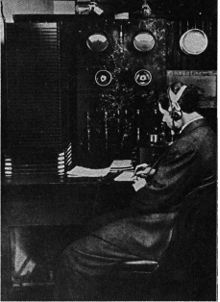 1916:
David Sarnoff. Rose from ranks of Marconi messenger boys to become chairman
of RCA. Wrote far reaching proposal for "radio music box:"
1916:
David Sarnoff. Rose from ranks of Marconi messenger boys to become chairman
of RCA. Wrote far reaching proposal for "radio music box:"
"... a radio telephone transmitter having a range of, say, 25 to 50 miles can be installed at a fixed point where the instrumental or voice music or both are produced. The problem of transmitting music has already been solved in principle, and therefore all the receivers attuned to the transmitting wavelength should be capable of receiving such music. The receiver can be designed in the form of a simple "Radio Music Box" and arranged for several different wavelengths, which should be changeable with the throwing of a single switch or pressing of a single button."
1919: RCA formed as a wholly US company from the British-owned Marconi Company. Held patent on DeForest triode valve, Westinghouse patents of Armstrong and Fessenden on heterodyne reception. Cross licenses patents with AT&T to centralize all intellectual property needed to commercialize broadcast radio (RCA uses patents for one-way broadcast, AT&T uses patents for two-way telephony).
1920: first radio station KDKA--Pittsburgh, PA. Broadcasts at 100W with 360 m waves. Covers Harding-Cox presidential election. Few radio receivers. 30 stations in operation by 1922 (100,000 radios sold), 556 in 1923 (500,000 radios sold).
1921: RCA generates huge profits from its combined dominance in radio broadcasting equipment and radio receivers. AT&T attempts to break the back of RCA by going into competition with them. AT&T's radio station begins "toll broadcasting," also known as commercials!
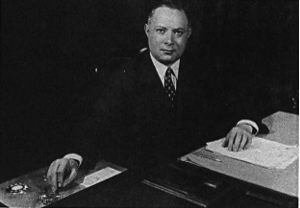 1922:
RCA spins off the National Broadcasting Corporation (NBC). AT&T gets
out of the broadcasting business.
1922:
RCA spins off the National Broadcasting Corporation (NBC). AT&T gets
out of the broadcasting business.
1930: 40% of American homes have a radio. By 1938, 82% of homes had one.
Late 1930s: RCA stalls FM developments. Wanted to sell AM sets and also focused on television development.
"Never before have I witnessed compressed into a single device so much ingenuity, so much brain power, so much development, and such phenomenal results." David Sarnoff on the Television
An ancient dream -- to be able to see beyond the horizon.
1872: Joseph May, worker at England's Telegraph Construction and Maintenance company, discovers by accident that the resistance of selenium rods -- being used as part of the equipment for the Transatlantic telegraph cable -- varies based on their exposure to light.
Visual telegraph a possibility -- light shining on a selenium cell could transmit a burst of electricity. Construct a matrix of such cells, convert current at receiving end back to light to reconstruct a picture. However selenium is not a good material to use. After exposure to light, takes along time before it is sensitive to light again. Won't work to send a rapid sequence of pictures to portray motion.
Throughout last part of 19th Century, many proposals for "electric telescopes." For example, M. Senleq of Ardres France proposes a system for "tracing" an object by moving a piece of selenium behind a lens that focused the object; the current sent would control a pencil at a distance that would draw the object focused through the lens!
1880: Maurice LeBlanc proposes a key feature--a mechanism by which a single "photocell" will trace the image in left-to-right, top-to-bottom fashion, and then repeats the process. Suggested a vibrating mirror scheme, but it never worked.
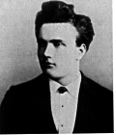 1883:
Paul Nipkow--the first simple method for scanning using a mechanical disk.
Close spiral of holes from edge to center drilled into a rigid disk. As
disk spins rapidly, sequence of holes scans a brightly lit picture or scene.
In one rotation, first hole scans one line of image, second hole scans next,
and so on. Light falls on a photoelectric cell; indicates intensity of incident
light. Could trigger an array of light bulbs to turn on and off at the receiving
end.
1883:
Paul Nipkow--the first simple method for scanning using a mechanical disk.
Close spiral of holes from edge to center drilled into a rigid disk. As
disk spins rapidly, sequence of holes scans a brightly lit picture or scene.
In one rotation, first hole scans one line of image, second hole scans next,
and so on. Light falls on a photoelectric cell; indicates intensity of incident
light. Could trigger an array of light bulbs to turn on and off at the receiving
end.
1900: First use of the word television, coined by Constantin Perskyi at the International Electricity Congress associated with the 1900 Paris Exposition.
1906: Max Dieckmann in Germany demonstrates the cathode ray tube:
 .
.
1908: A. A. Campbell Swinton suggestions the possibility of an all electronic system based on cathode ray oscilloscope. Heated cathode generates electrons, directed to phosphorous-coated tube surface via two pairs of charged plates: one horizontal, one vertical. Uniformly increasing voltage applied to vertical pair causes a vertical line to be drawn on the tube. A small increase in voltage on the horizontal pair causes the next line to be drawn above the previous. "Progressive scan." Intensity of point of light can be varied to correspond to bright or dim points of light.
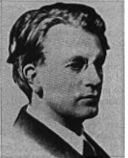 A inventor and tinkerer
overpoweringly motivated by the desire to make a great fortune. Very limited
technical training or expertise.
A inventor and tinkerer
overpoweringly motivated by the desire to make a great fortune. Very limited
technical training or expertise.
Early 1920s: Receives credit for developing the first working television set: a contraption in which light fell on a cross, the light and shadow of which fell on a rotating Nipkow disk, which impinged on a selenium cell, which controlled another light that turned on and off, which was then view through a second spinning disk synchronized with the first. Fundamental quality limit is how many times per second can you rotate the disk -- lines per image, images per second. 10 times per second is not good enough. Such an electromechanical approach was finally surpassed by an all electronic system some years later.
"I attended a demonstration of Mr. Baird's apparatus and was very favourably impressed with the results. His machinery is, however, astonishingly crude and the apparatus in general is built out of derelict odds and ends. The optical system is composed of lenses out of bicycle lamps. The framework is an inimpressive erection of old sugar boxes and the electrical wiring a nightmare cobweb of improvisations. The outstanding miracle is that he has been able to produce any result at all with the indifferent material at his disposal." Editor of Discovery Magazine, writing at the time.
1925: Marries the Nipkow disk to radio transmission. Builds an electromechanical system that transmits its signals by radio to a receiving device. Demonstrates the system at Selfridge's department store in London. Outlines and shapes could be seen, but little detail.
"Selfridge's presents the first public demonstration of television in the Electrical Section (First Floor). Television is to light what telephony is to sound -- it means INSTANTANEOUS transmission of a picture, so that the observer at the receiving end can see, to all intents and purposes, what is cinematographic view of what is happening at the sending end. For many years experiments have been conducted with this end in view; the apparatus that is here being demonstrated, is the first to be successful."
1927: Numerous demonstrations follow. Is celebrated throughout England. Forms a company, Baird Television, Ltd., and floats a stock offering to further the development of his television system.
1928: Baird transmits first moving image across the Atlantic.
1929: BBC commences regular television broadcasts using Baird's system. Three half hours per week, beginning at midnight. Huge contraption yielding very crude picture quality (30 line picture).
1932: Pay TV--Baird develops system that can deliver images to 9 foot by 6 foot screen in theatres.
1937: Despite incremental improvements in Baird's system, an all electronic system generated much better quality images.
"All the way back to the studio Mr. Baird was busily extolling the virtues his mechanical system over Farnsworth's. As they came to the door, Mr. Baird, still in argument, caught sight of the picture on the monitor and became silent. He advanced slowly, as if hypnotized, until he was standing directly before it. He stood there for a time; then breaking the spell with a visible effort, he turned without a word and left. With great empathy, Phil watched him go, aware Mr. Baird had seen the death knell of his beloved spinning disc." Pem Farnsworth
A professional inventor and promoter. In 1895, he invented the first practical motion picture projector: the "Projecting Phantoscope." In 1920, he improved the projector by replacing the shutter mechanism, with its abrupt open-close function, with a rotating prism that continuously bent the light as the film moved past. This made high speed slow motion possible. It also suggested an alternative scanning mechanism for television.
1921: Jenkins Laboratories founded in Washington DC, to "develop radio movies to be broadcast for entertainment in the home." October 1921 transmits pictures over telephone wires.
1925: Demonstrates "radio vision"-- a 48 line moving picture of a windmill transmitted via radio for Bureau of Standards and the US Navy. Note that he had hooked up the system to a movie projector, not a camera! Beat out by Baird, who two months earlier had demonstrated his system in England. (Today's US TV standard is 525 lines per image).
1927: Markets his radiovisor. Moving images with no sound. Regular broadcasts begin on 2 July 1928. MWF at 8 PM. Jenkins Television Corporation founded with initial stock offering of $10 million.
1929: Broadcast station in Jersey City, NJ. 6 nights a week from 8-9 PM.
1931: Jenkins universal television receiver costs $82.95; $42.50 for the build it yourself kit. 60 line pictures. 4 hours of broadcasting per day, except Sunday.
1925: Alexanderson of RCA and General Electric demonstrates the principles for his television system. Horizontal bar of light passed through a prism and projected onto a phtoelectrical cell. Current transmitted by radio, where used to control mirror of a standard oscillograph. Lenses and arc produce a light beam passed through a crystal and focused on a screen. January 1927: Alexanderson successfully demonstrates transmission of film strip via wireless. Moving pictures, but still using mechanical devices for scanning and displaying. Capture devices is based on a rotating mirror drum rather than Nipkow disk. As drum rotates, mirror reflects additional points onto photocell.

Scheme actually used two light beams producing 48 lines with 24 mirrors, the two beams working alternatively in an interlaced fashion. January 1928: Begins experimental broadcasts in Schenectedy NY. August 1928: TV camera housing 1000 W bulb, 24 hole spinning disk.
April 1927: AT&T Bell Labs demonstrates their system for television in New York. Secretary of Commerce Herbert Hoover transmitted over the system from Washington using telephone cables. Vaudeville act sent over radio waves.
"The Examiner says today that Philo T. Farnsworth, young San Francisco inventor, has perfected a new system of radio television which does away with the revolving disk feature, reproduces objects in great detail, and can be manufactured ato retail at $100 or less." N.Y. Times, 1928.
1921: 14 year old Farnsworth has vision of how to build television system from horizontal beams. Inspiration comes from viewing the perfect rows of his mowed hay field.
1922: Develops concept for TV camera tube similar to Zworykin's. Electron beam does not scan image, rather image is magnetically focused onto an anode aperature. Light areas generate current, allowing an electrical picture to be formed.
1926: Independent investors and Crocker Bank bankroll 20 year old Farnsworth's Green Street Laboratory in San Francisco. Head of UC Berkeley's Glassblowing Labs, Bill Cummings, helps to construct the delicate cathode ray tubes.
1927: First patent filings for Farnsworth's all electronic system.
1928: Invents the electron-multiplier tube or multipactor. Makes it possible to amplify signals over very wide wave bands. Obviates the need for very high wattage lights at the transmitting cameras. August 24: demonstrates system to Pacific Telephone. September 2: first demonstration to the press. 20 pictures per second, screen is 1.25 inches square.
1929: Develops the vacuum tube generator for generating control signals for image scanning. True all-electrical solution now in hand.
1930: Zworykin visits Farnsworth's lab and walks away with much information. Farnsworth's initial patents granted. Test transmissions from Green Street to Merchant Exchange Building, a mile away.
1931: Philco to build sets to Farnsworth's designs. Moves to Philadelphia. Breaks with them in 1933 and sets up own company to develop and market television.
1935: Farnsworth wins significant patent victory against Zworykin and RCA. Recognized as having built the first operational all electronic television system. Refuses to sell patents to RCA. Receives patent licensing fees until his patents expire. With WW II approaching, and the delay in the deployment of television, he reaps little in the way of income from these licensing fees.
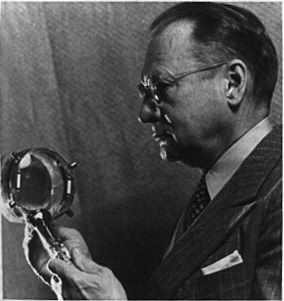
1907: Young student at St. Petersburg Technological Institute. Works with Boris Rosing on a system with mechanical pickup and cathode tube receiver.
Emigrates to NY after Russian Revolution.
1923: Working at Westinghouse. Develops an electronic scanning television camera. Light from scene impinges on a photosensitive surface. Scanning electron beam pass over this surface from the rear. Beam is absorbed at light points, reflect at dark points. Surge in electricity due to absorption could be measured to indicate light and dark areas of image.
1929: Not allowed to work on television at Westinghouse, he gains Sarnoff's sponsorship to continue the work. Demonstrates his own all-electric camera/receiver. Designs the Kinescope, based on CRT storage ability--stores image between line scans--makes possible brighter pictures. Needs a camera technology of similar high quality.
1930: RCA is reorganized. Sarnoff becomes President. New research laboratories established in Camden, NJ. Zworykin leads the Television Laboratory. He would eventually become the Chief Engineer of RCA.
1931: Builds the Iconoscope camera--a single sided tube where the projected image and the scanning electron beam fall on the same side of a photoelectric plate. Depended on the storage concept to work.
1933: RCA team builds and demonstrates their first all electronic system.
1939: April 20--Television broadcast from NY World's Fair. "Every detail was distinct, even the fleecy texture of the clouds."
"It is with feeling of humbleness that I come to this moment of announcing the birth in this country of a new art so important in its implications that it is bound to affect all society. It is an art which shines like a torch of hope in a troubled world. It is a creative force which we must learn to utilize for the benefit of all mankind." David Sarnoff, 1939
$1000 for a 7 x 10 inch picture console. Few are sold!
1940: RCA begins to lose control of television. NTSC video standard determined. 525 lines, 30 frames per second, AM for picture, FM for sound, 4 x 3 aspect ratio.
1902: Otto von Bronk--describes a system with a mirror drum, selenium cell, tubes and colored filters. Sequential system--scan picture with red filter, then blue filter, then green filter.
1924: Harold McCreary, Associated Electric Laboratories, Chicago--simultaneous system: separate camera tubes for R, G, B. At receiver, 3 tubes recreate the image.
1929: Bell Labs demonstrates simultaneous color system using spinning disk mechanism. Used banks of photocells and filters to reproduce colored signals, mirrors to mix them on receiving screen.
1950: FCC approves CBS's system of color television, based on mechanical scanning! First color broadcast on June 25, 1951. 12 million TV sets in existence, of which 2 dozen could receive CBS color.
RCA continues developing an all electronic system, led by Alfred Goldsmith and later Harold Law. Regular monochromatic camera tube with dichroic mirrors. Blue, red, green mirrors focus image of appropriate color components. RCA tricolor picture tube converts these back to color. Compatible with the existing black and white system. Actual signals sent as luminance and chromanence signals. B&W sets pick up the former and ignore the latter.
1953: FCC changes its mind. The RCA system is adopted.
1954: 12.5 inch screen, $1000 color TV vs. $300 21 inch B&W set. Only 5000 sets sold during year.
1960: Walt Disney's Wonderful World of Color finally launches color TV.
1990: General Instrument announces the first all digital TV system. Home receiver becomes a computer in its own right.